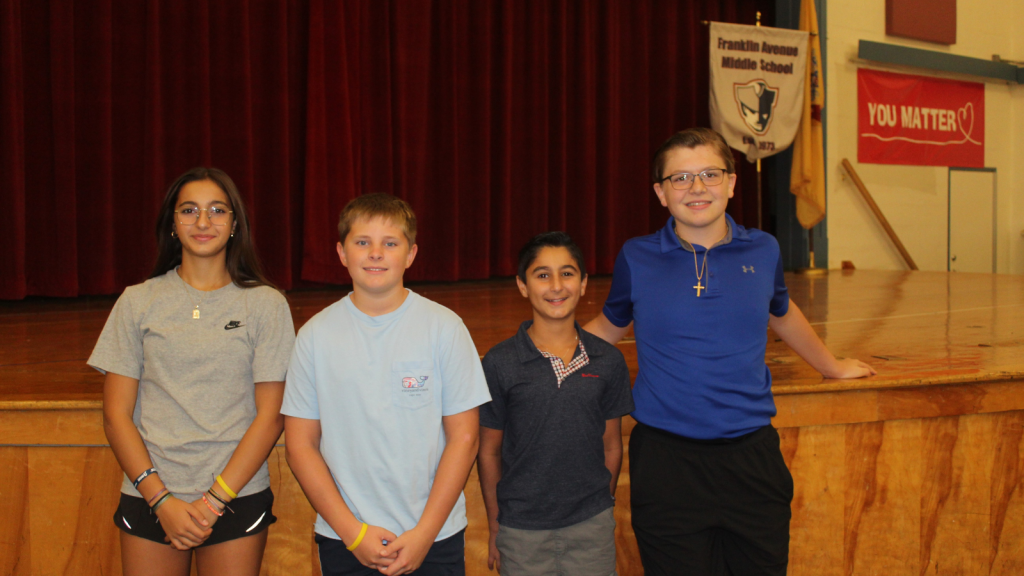Save the bees. That was the aim of Team Passion Project, the winners of the second annual Solve Together Challenge, a national competition designed to encourage career exploration and skill-building for middle school students. The team, comprised of seventh grader from Franklin Avenue Middle School, could either select from a list of real-world problems or choose their own to solve. That choice ended up being central to their success. Joe Mazza and Phyllis Fagell sat down with the students and their supporting teachers at the #AMLE22 Annual Conference earlier this month to learn more. Listen to their discussion on the Middle School Walk and Talk podcast or enjoy the written recap here.
The purpose of the competition, which is offered in partnership by American Student Assistance and AMLE, is to showcase what young people are capable of when give the opportunity to think outside the box. “In most of our classes, we can’t really build what we want,” explained Michael Snono, one four students who comprised Team Passion Project, “In this project, we had more freedom to choose what we wanted to do. We chose the problem and we chose the solution.” As their solution, the students conceived a transportation method that allows bees to be brought to pollination zones without being overheated. Their protype vehicle even included some of the plants bees love the most on board to create a sense of comfort for them. Selecting their own problem made them feel more invested in the work, added fellow teammate Thomas Esposito, “It felt different. It encouraged us because we picked a topic that we all enjoyed working on.”
The results also serve to highlight why projects like this one are so critical in the middle grades. For Michael, he realized how important it is to learn to work as a team. “You all brought very different skills to the table, and that ability to work as a team is challenging,” observed Phyllis Fagell, author of Middle School Matters, “but that teamwork is an essential skill to learn at this age.” Thomas admitted that while they functioned well as a team overall, there were times that they struggled.
That struggle, too, was a key part of the learning process. For Michael, learning to be part of a team meant figuring out how to trust each other, “Most of the time, the reason some people don’t do the work is because one person takes charge and they don’t listen to the ideas of others.” He said he now sees the value of coming together at the beginning of a project to listen to everyone’s ideas and that even team leaders should be open minded throughout the process. The team also learned to harness each member’s strengths to the advantage of the whole, “In middle school, every student is different. Everyone learns in their own unique way,” said Michael, “Some people need to see, hear, or draw something to learn. Some people have weaknesses and strengths in different categories.”
Offering choice in the curriculum can give us a window into activating our students, says Joe Mazza, principal of Seven Bridges Middle School in New York. “When teachers really get to know their students, they learn what they do and what they’re interested in – instead of having all students learn the exact same skills. If we don’t know you, we can’t put you in a position to be successful.” Gina Aielo, an instructional coach who supported the students of Team Passion Project, agrees, “I was able to help them foster their creativity and really take a look at their individual interests.” This included exploring career paths that align with those interests, added Alyssa McAloney, the team’s teacher. The team interviewed several professionals, including beekeepers and bee researchers when designing their prototype. “These are resources we wouldn’t have been able to offer them as teachers,” she said.
Evidence shows that students thrive when they are able to make choices about their learning and to dialogue with teachers and one another about what and how to learn. But sometimes it takes opportunities like the Solve Together Challenge to remember what an impact these choices can have for students and their teachers. For McAloney and Aielo, watching the success of their students was a professional highlight. “It’s really exciting to see what middle schoolers can do when we give them the freedom to be themselves in the classroom,” added Aielo.
AMLE congratulates Team Passion Project from Franklin Avenue Middle School in Franklin Lakes, NJ. Pictured above from left to right are Evva Vassiliou, Bradley Vierheilig, Michael Snono, and Thomas Esposito.

Based on my experiences in the classroom, I can attest to the fact that providing choice at any point throughout instruction is essential for (1) making learning a meaningful experience and (2) enhancing student engagement. Perhaps one of the reasons why many teachers have avoided the element of choice in the past is the fact that it simply requires more “work”. That is, if we want to give our students more autonomy and responsibility throughout the learning process, then we must first learn what interests and engages them. Only after we make a conscious effort to do so can we effectively shift the responsibility for learning onto our students.
I agree, students do thrive when they are able to make choices. When students are given the option on speaking out loud, this gives them the motivation to connect and be apart of something bigger. I had no idea that when some student take “charge” in big discussion, that they don’t learn as well due to not hearing others opinions or inputs.